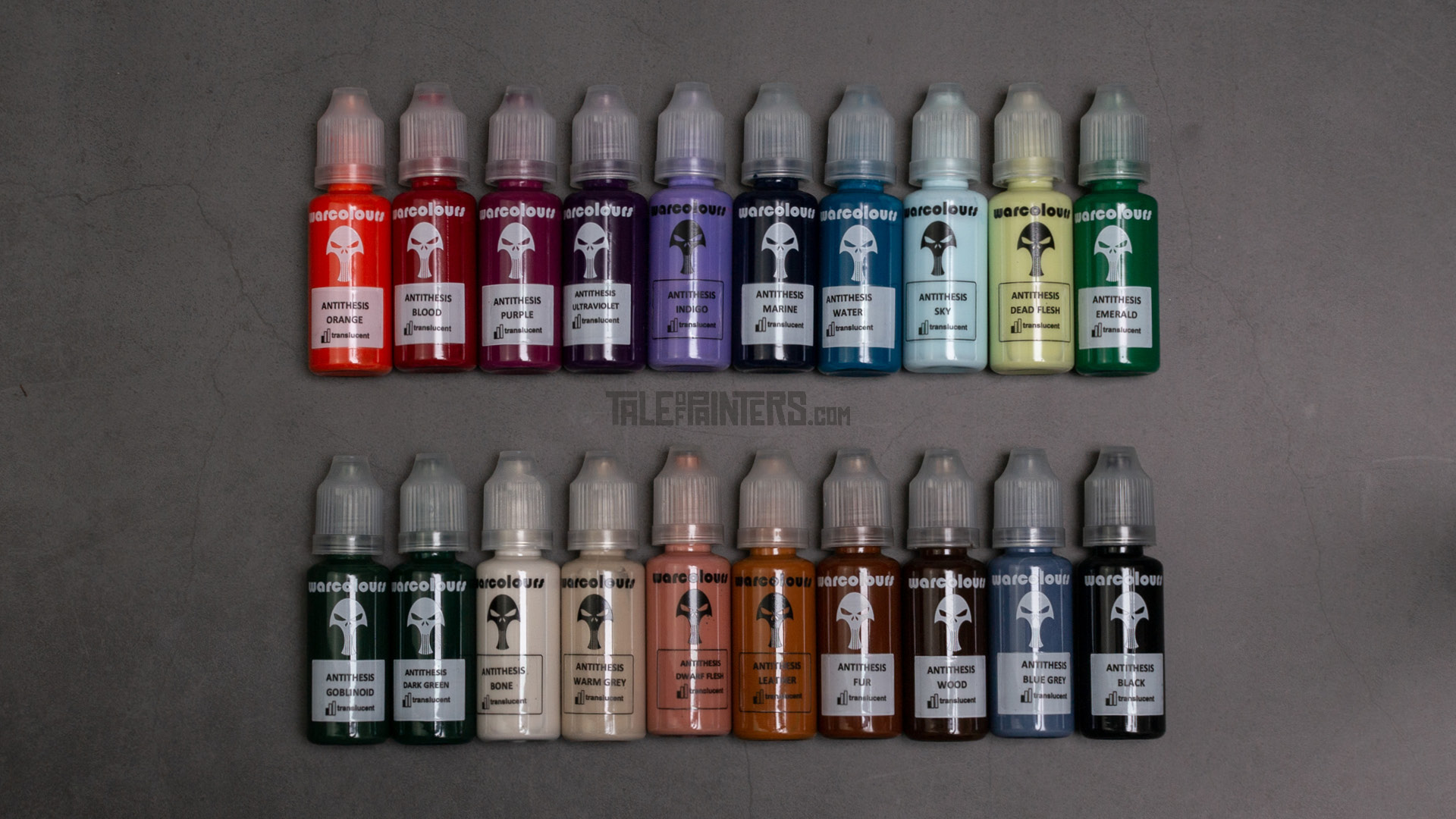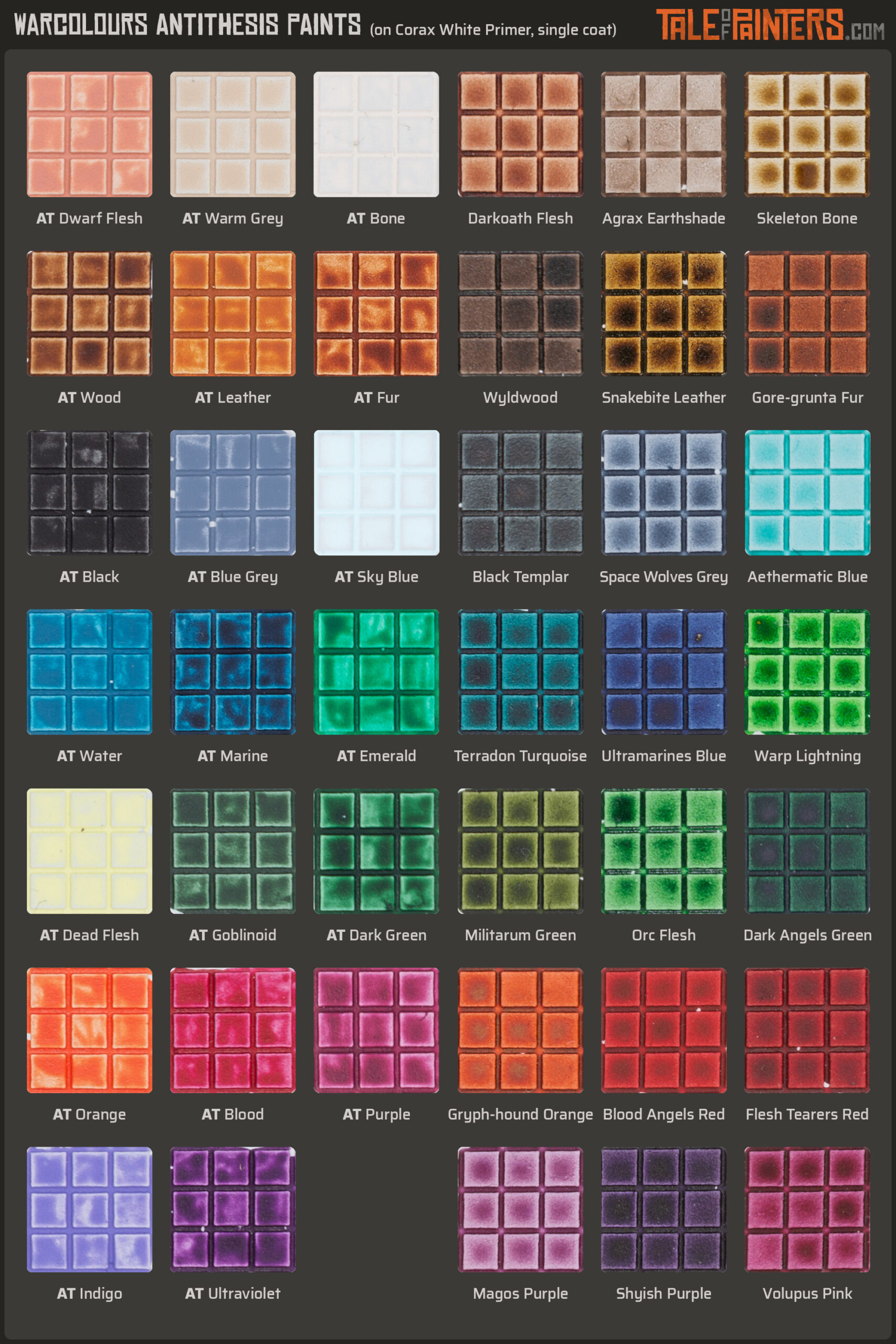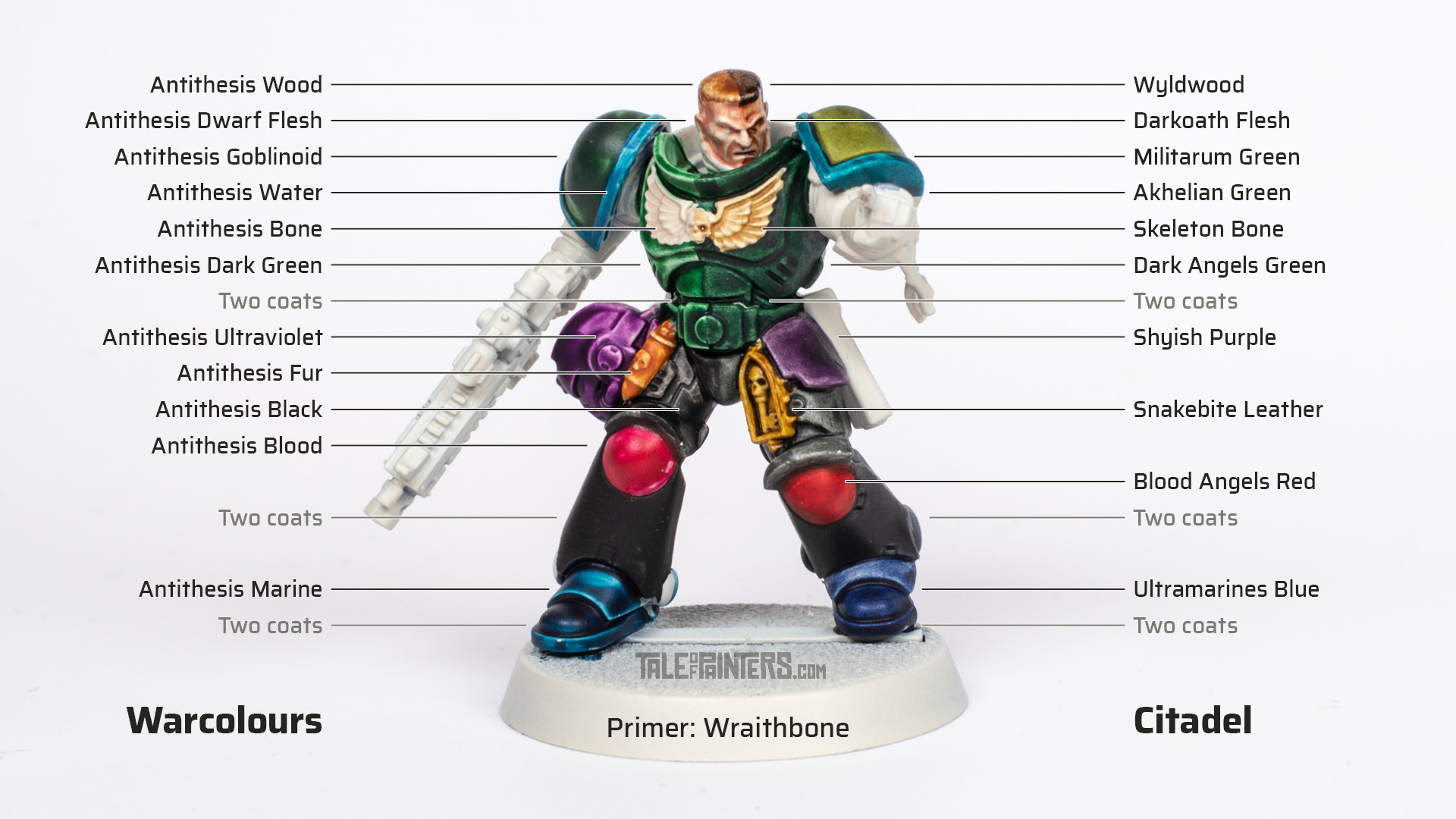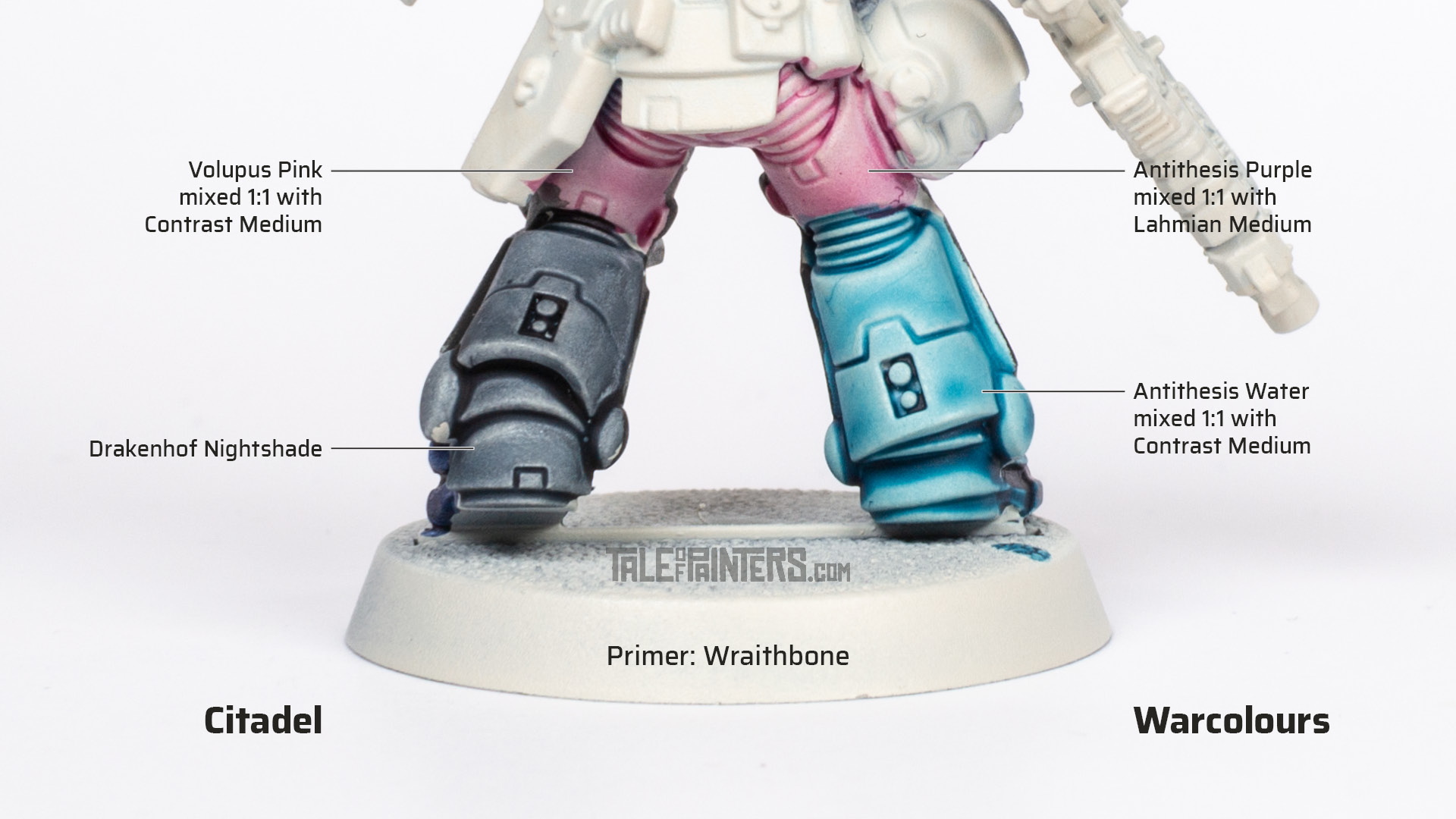Warcolours just released their answer for Citadel’s Contrast paint range: Antithesis “Wash’n’Go” paints which promise a basecoat with highlights and shadows with just a single coat. In this review, we take a closer look and find out if they can beat their Citadel counterparts.
Warcolours is a Greece manufacturer who produces a huge range of handmade acrylic paints. We reviewed the basic acrylic layer paints a couple of years ago. Since then, Warcolours released a plethora of paint ranges, such as transparent, glaze, shade, metallic, gem, and fluorescent paints, as well as inks, auxiliaries, and much more. There is even a “Nostalgia” paint range that tries to recreate the colours of Citadel’s paint range from the late 80s. Warcolours is also a company dedicated to sustainable production, which we really appreciate.


These items were kindly provided by Warcolours. Opinions are our own.
The Antithesis range comprises 36 colours, two more than Citadel’s Contrast range. There is also a specific Antithesis primer, and a Contrast medium.
Features
Antithesis paints come in transparent 15 ml dropper bottles with a child-proof cap and a thin nozzle. After playing around with the twenty colours we received, it’s clear that Antithesis paints rely on a very different formula than Citadel Contrast.
Contrast paints are basically inks with a unique medium that has a lower viscosity than the medium used in most other miniature inks and washes. Inks and Shades/Washes are transparent solutions that contain dye as a colourant. They require a light basecoat as they “dye” the surface. The more coats you apply, the more intense and darker the colouration will be. On a dark basecoat, the effect will be all but lost, as inks aren’t opaque as regular paints. You can find out more about Contrast paints in our comprehensive review.
Antithesis paints on the other hand aren’t ink based, but based on highly pigmented acrylic paint. Think of Citadel Base paints but with a more gel-like medium. When you apply them to a model, the surface tension of the gel medium will pull the pigments away from the edges and towards the recessed parts of the model, creating a natural shading. However, as Antithesis paints are pigment based, they don’t darken or dye in the same way as Contrast Paints or Shades/Washes do. The colour you see in paint bottle is as dark as it gets, no matter how many coats you apply. Think of regular acrylic paints – the more coats you apply, the more opaque the result will become, but not darker.


Here you can see a comparison between a number of Warcolour’s Antithesis paints and Citadel’s Contrast paints. Each square shows a single coat of Antithesis or Contrast paint on Corax White primer, which is an almost white grey. As you can see, Antithesis paints are very vibrant and dry matte. Some colours such as Bone, Sky Blue, or Dead Flesh are so light they’d require a pure white primer. You can also see that on flat areas, the more gel-like formula of Antithesis paints dries more unevenly than Citadel Contrast, resulting in visible brush strokes and stains.


This is a test model, a humble Primaris Intercessor Sergeant of the Contrast Warriors chapter. The left half was painted with Warcolour’s Antithesis Paints over Wraithbone Contrast primer, the right half with Contrast Paints.
Antithesis paints flow nicely into the recessed parts of the model, but on the flat panels of power armour the result is rather uneven. Contrast Paint isn’t perfect in this regard either, and some paints are better than others, but in direct comparison, the finish is smoother. Similar to Contrast Paints, the result will be smoother when you apply two coats of Antithesis paints, but because of their opaque nature, a lot of the shading will be lost in the process.


When thinned with Contrast or Lahmian Medium, Antithesis paints make really nice washes thanks to their vibrant hues. The opacity of the pigment-based formula makes Antithesis based washes very similar to Citadel Technical Paint Nihilakh Oxide, which means they’ll also work over dark or even black basecoats, for example for creating glow effects or weathering like rust or grime. If you love Nihilakh Oxide and thought you wanted more washes like that, Antithesis paints are worth a look.
Value
Warcolours are availaible directly from warcolours.com. Single paints are 2,89 Euro for 15 ml (0,19 Euro per ml), which is much more affordable than Contrast Paints, which are 18 ml for 6,30 Euro (0,35 Euro per ml). There is also a paint set with all 36 Antithesis paints for 99,99 Euro (0,185 Euro per ml), so the saving is veryy modest. When ordering from Warcolours you also need to consider the flat 8,95 Euro shipping cost for worldwide shipping. Free shipping is available for orders over 200 Euro.
6.0Score
Pros
- Vibrant colours
- Make great washes when mixed with Contrast or Lahmian Medium
- Price per ml is very reasonable
Cons
- Formula is very different to Contrast Paints
- Don't create as dark shadows
- Leave a more uneven finish on flat areas
Final Verdict
Can Warcolours beat or replace Citadel Contrast paints? Hardly. The Antithesis paints' formula and feel are totally different. Shadows aren't as deep and they struggle on flat areas. That's not to say that Antithesis paints don't have a use. They do their trick on very textured sculpts and thinned with a medium like Lahmian or Contrast Medium they make great opaque washes. However, as a one coat beginner-friendly painting solution, they just don't work as well as Contrast paints (which also show their limits on details such as flat armour panels).








I know it’s not the sites goal, but seeing them on some Infinity minis would be dope, or even something that wasn’t as flat panel heavy as a space marine.
Love your stuff.
Warcolours makes wonderful paints. Their white is especially good and it takes a little longer to dry than other paints, which works great for certain techniques. Your article reminded me to place an order for more. Thanks!
You’re welcome. A good white is worth its weight in gold!
How did they fare on more textured areas like the face or ribbing between panels? It’s a little difficult to see (on mobile at least), but it would be a shame if they totally failed to live up to expectations!
Their website doesn’t seem to have any examples (unless I simply looked too hastily) but it would be interesting to see how they look on fabric or other textured surfaces.
They definitely work best on highly textured areas such as fur or ribbing. You might want to have a look on a desktop monitor so you can zoom into the image. On the face, the Dwarf Flesh Antithesis paint works well, but I feel that Wraithbone is too light as a basecoat, so I’d recommend starting with Kislev Flesh or something similar and then painting a thinned darker warm brown into the recesses to add some more contrast to the shadows.